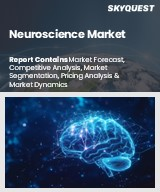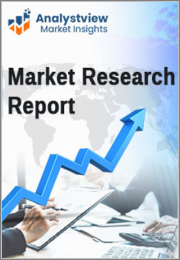
|
시장보고서
상품코드
1764803
신경과학 시장(2025-2032년) : 컴포넌트별, 기술별, 최종 사용자별, 지역별 규모, 점유율 및 성장 분석과 산업 예측Neuroscience Market Size, Share, and Growth Analysis, By Component (Instruments, Consumables), By Technology (Brain Imaging, Neuro-Microscopy), By End-user, By Region - Industry Forecast 2025-2032 |
||||||
신경과학 세계 시장 규모는 2023년 405억 달러를 달성하였고 예측기간(2025-2032년) 동안 CAGR 5.1%로 2024년 425억 7,000만 달러에서 2032년에는 633억 7,000만 달러로 성장할 전망입니다.
세계의 신경과학 시장은 소비자 행동의 변화, 정부의 이니셔티브 및 기술의 진보로 큰 성장을 기대하고 있습니다. 각국 정부는 신경과학 분야에 투자를 진행하고 있습니다. 싱가포르에서는 2024년 개시된 웨어러블 뇌파계와 뉴로피드백 장치를 포함한 전국적인 신경 데이터 분석 플랫폼에 의해 스마트 헬스 구상을 실현하고 있습니다. 이 장치는 다양한 건강 관리 환경에서 뇌파 활동과 스트레스 수준에 대한 실시간 신경학적 데이터를 수집합니다. 이를 통해 정신 건강 문제의 스크리닝과 모니터링이 더욱 개선될 것으로 예측됩니다. 한편, 머신러닝과 AI는 초개인화 치료를 가능하게 하고 5G의 보급은 원격 신경 모니터링 기능을 강화하여 시기 적절한 개입을 향상시켜 의료 기술의 지속 가능성을 촉진합니다.
목차
소개
- 조사 목적
- 조사 범위
- 정의
조사 방법
- 정보 수집
- 2차 및 1차 데이터 방법
- 시장 규모 예측
- 시장의 전제조건과 제한
주요 요약
- 세계 시장 전망
- 공급과 수요 동향 분석
- 부문별 기회 분석
시장 역학과 전망
- 시장 개요
- 시장 규모
- 시장 역학
- 성장 촉진요인과 기회
- 억제요인과 과제
- Porter's Five Forces 분석
주요 시장 인사이트
- 주요 성공요인
- 경쟁도
- 주요 투자 기회
- 시장 생태계
- 시장의 매력 지수(2024년)
- PESTEL 분석
- 거시경제지표
- 밸류체인 분석
- 가격 분석
- 사례 연구
- 고객 구매행동 분석
신경과학 시장 규모 : 컴포넌트별 &CAGR(2025-2032년)
- 시장 개요
- 기기
- 소모품
- 소프트웨어 및 서비스
신경과학 시장 규모 : 기술별&CAGR(2025-2032년)
- 시장 개요
- 뇌 이미지
- 신경 현미경 검사
- 뇌정위수술
- 뉴로 프로테오믹스 해석
- 신경세포 조작
- 기타
신경과학 시장 규모 : 최종 사용자별 &CAGR(2025-2032년)
- 시장 개요
- 병원
- 진단 실험실
- 조사 학술 기관
신경과학 시장 규모 : 지역별&CAGR(2025-2032년)
- 북미
- 미국
- 캐나다
- 유럽
- 독일
- 스페인
- 프랑스
- 영국
- 이탈리아
- 기타 유럽
- 아시아태평양
- 중국
- 인도
- 일본
- 한국
- 기타 아시아태평양
- 라틴아메리카
- 브라질
- 기타 라틴아메리카
- 중동 및 아프리카
- GCC 국가
- 남아프리카
- 기타 중동 및 아프리카
경쟁 정보
- 상위 5개사 비교
- 주요 기업의 시장 포지셔닝(2024년)
- 주요 시장 기업이 채용한 전략
- 최근 시장 동향
- 기업의 시장 점유율 분석(2024년)
- 주요 기업의 기업 프로파일
- 기업의 상세
- 제품 포트폴리오 분석
- 기업의 부문별 점유율 분석
- 전년 대비 수익 비교(2022-2024년)
주요 기업 프로파일
- Carl Zeiss AG
- Danaher Corporation
- GE Healthcare
- Siemens Healthcare Private Limited
- Koninklijke Philips NV
- Canon Inc.
- B. Braun SE
- Medtronic
- Stryker
- Boston Scientific Corporation
- ABBOTT
- Terumo Corporation
결론과 권고
CSM 25.07.15Global Neuroscience Market size was valued at USD 40.5 billion in 2023 and is poised to grow from USD 42.57 billion in 2024 to USD 63.37 billion by 2032, growing at a CAGR of 5.1% during the forecast period (2025-2032).
The global neuroscience market is poised for significant growth driven by shifts in consumer behavior, government initiatives, and technology advancements. Authorities worldwide are investing in neuro-digital infrastructure to enhance smart healthcare and cognitive diagnostics. In Singapore, the Smart Health initiative is exemplified by a nationwide neural data analytics platform incorporating wearable EEG and neurofeedback devices, set for full deployment by 2024. These devices gather real-time neurological data on brainwave activity and stress levels in various healthcare settings. The rise of public-private partnerships, such as those between ST Engineering and NeuroSky, is expected to further advance screening and monitoring for mental health issues through 2025. Meanwhile, machine learning and AI are enabling hyper-personalized therapies, and the proliferation of 5G is enhancing remote neuro-monitoring capabilities, improving timely interventions and promoting sustainability in medical technology.
Top-down and bottom-up approaches were used to estimate and validate the size of the Global Neuroscience market and to estimate the size of various other dependent submarkets. The research methodology used to estimate the market size includes the following details: The key players in the market were identified through secondary research, and their market shares in the respective regions were determined through primary and secondary research. This entire procedure includes the study of the annual and financial reports of the top market players and extensive interviews for key insights from industry leaders such as CEOs, VPs, directors, and marketing executives. All percentage shares split, and breakdowns were determined using secondary sources and verified through Primary sources. All possible parameters that affect the markets covered in this research study have been accounted for, viewed in extensive detail, verified through primary research, and analyzed to get the final quantitative and qualitative data.
Global Neuroscience Market Segments Analysis
Global Neuroscience Market is segmented by Component, Technology, End-user and region. Based on Component, the market is segmented into Instruments, Consumables and Software & Services. Based on Technology, the market is segmented into Brain Imaging, Neuro-Microscopy, Stereotaxic Surgeries, Neuro-Proteomic Analysis, Neuro-Cellular Manipulation and Others. Based on End-user, the market is segmented into Hospitals, Diagnostic laboratories and Research and Academic Institute. Based on region, the market is segmented into North America, Europe, Asia Pacific, Latin America and Middle East & Africa.
Driver of the Global Neuroscience Market
The global neuroscience market is being significantly influenced by the integration of artificial intelligence (AI) and machine learning technologies in brain health management. These innovations enable real-time analysis of neural data, allowing for early recognition of patterns and customized cognitive therapy solutions that have transformed the field. Additionally, AI-driven applications, such as natural language processing (NLP) and computer vision algorithms, enhance the accuracy with which physicians interpret complex brain imaging and neurophysiological signals compared to traditional methods. The rise in popularity of AI-integrated brain-computer interfaces (BCIs) is also shaping neurorehabilitation, prosthetic control, and communication enhancements for patients with severe brain injuries.
Restraints in the Global Neuroscience Market
The Global Neuroscience market faces significant constraints due to the substantial financial investment required for acquiring, installing, calibrating, and maintaining advanced neuroscience technologies. Cutting-edge tools such as functional magnetic resonance imaging (fMRI), magnetoencephalography (MEG) systems, electrocorticography (ECoG), brain-computer interfaces (BCIs), and high-resolution neuroimaging platforms demand considerable resources, making them costly for research institutions and healthcare facilities. This financial barrier can limit accessibility and hinder widespread adoption of these critical technologies, potentially slowing advancements in neuroscience research and clinical applications. As a result, the high costs associated with these sophisticated tools pose a notable challenge to the industry's growth.
Market Trends of the Global Neuroscience Market
The Global Neuroscience market is experiencing a significant transformation driven by the integration of AI-powered precision diagnostics and programmatic decision-making. Similar to how programmatic advertising reshaped digital marketing, AI-driven analytics are enhancing neuroscience diagnostics through predictive modeling, automated neural image processing, and advanced EEG interpretation. This shift enables real-time, data-informed decisions, which optimize treatment protocols, streamline clinical workflows, and enhance diagnostic accuracy by adapting strategies based on immediate neural feedback. As a result, leading healthcare providers and med-tech innovators now regard widespread AI integration as a vital strategy for improving patient outcomes and increasing the efficiency of clinical interventions within the neuroscience sector.
Table of Contents
Introduction
- Objectives of the Study
- Scope of the Report
- Definitions
Research Methodology
- Information Procurement
- Secondary & Primary Data Methods
- Market Size Estimation
- Market Assumptions & Limitations
Executive Summary
- Global Market Outlook
- Supply & Demand Trend Analysis
- Segmental Opportunity Analysis
Market Dynamics & Outlook
- Market Overview
- Market Size
- Market Dynamics
- Drivers & Opportunities
- Restraints & Challenges
- Porters Analysis
- Competitive rivalry
- Threat of substitute
- Bargaining power of buyers
- Threat of new entrants
- Bargaining power of suppliers
Key Market Insights
- Key Success Factors
- Degree of Competition
- Top Investment Pockets
- Market Ecosystem
- Market Attractiveness Index, 2024
- PESTEL Analysis
- Macro-Economic Indicators
- Value Chain Analysis
- Pricing Analysis
- Case Studies
- Customer Buying Behavior Analysis
Global Neuroscience Market Size by Component & CAGR (2025-2032)
- Market Overview
- Instruments
- Consumables
- Software & Services
Global Neuroscience Market Size by Technology & CAGR (2025-2032)
- Market Overview
- Brain Imaging
- Neuro-Microscopy
- Stereotaxic Surgeries
- Neuro-Proteomic Analysis
- Neuro-Cellular Manipulation
- Others
Global Neuroscience Market Size by End-user & CAGR (2025-2032)
- Market Overview
- Hospitals
- Diagnostic laboratories
- Research and Academic Institute
Global Neuroscience Market Size & CAGR (2025-2032)
- North America (Component, Technology, End-user)
- US
- Canada
- Europe (Component, Technology, End-user)
- Germany
- Spain
- France
- UK
- Italy
- Rest of Europe
- Asia Pacific (Component, Technology, End-user)
- China
- India
- Japan
- South Korea
- Rest of Asia-Pacific
- Latin America (Component, Technology, End-user)
- Brazil
- Rest of Latin America
- Middle East & Africa (Component, Technology, End-user)
- GCC Countries
- South Africa
- Rest of Middle East & Africa
Competitive Intelligence
- Top 5 Player Comparison
- Market Positioning of Key Players, 2024
- Strategies Adopted by Key Market Players
- Recent Developments in the Market
- Company Market Share Analysis, 2024
- Company Profiles of All Key Players
- Company Details
- Product Portfolio Analysis
- Company's Segmental Share Analysis
- Revenue Y-O-Y Comparison (2022-2024)
Key Company Profiles
- Carl Zeiss AG
- Company Overview
- Business Segment Overview
- Financial Updates
- Key Developments
- Danaher Corporation
- Company Overview
- Business Segment Overview
- Financial Updates
- Key Developments
- GE Healthcare
- Company Overview
- Business Segment Overview
- Financial Updates
- Key Developments
- Siemens Healthcare Private Limited
- Company Overview
- Business Segment Overview
- Financial Updates
- Key Developments
- Koninklijke Philips N.V.
- Company Overview
- Business Segment Overview
- Financial Updates
- Key Developments
- Canon Inc.
- Company Overview
- Business Segment Overview
- Financial Updates
- Key Developments
- B. Braun SE
- Company Overview
- Business Segment Overview
- Financial Updates
- Key Developments
- Medtronic
- Company Overview
- Business Segment Overview
- Financial Updates
- Key Developments
- Stryker
- Company Overview
- Business Segment Overview
- Financial Updates
- Key Developments
- Boston Scientific Corporation
- Company Overview
- Business Segment Overview
- Financial Updates
- Key Developments
- ABBOTT
- Company Overview
- Business Segment Overview
- Financial Updates
- Key Developments
- Terumo Corporation
- Company Overview
- Business Segment Overview
- Financial Updates
- Key Developments


















